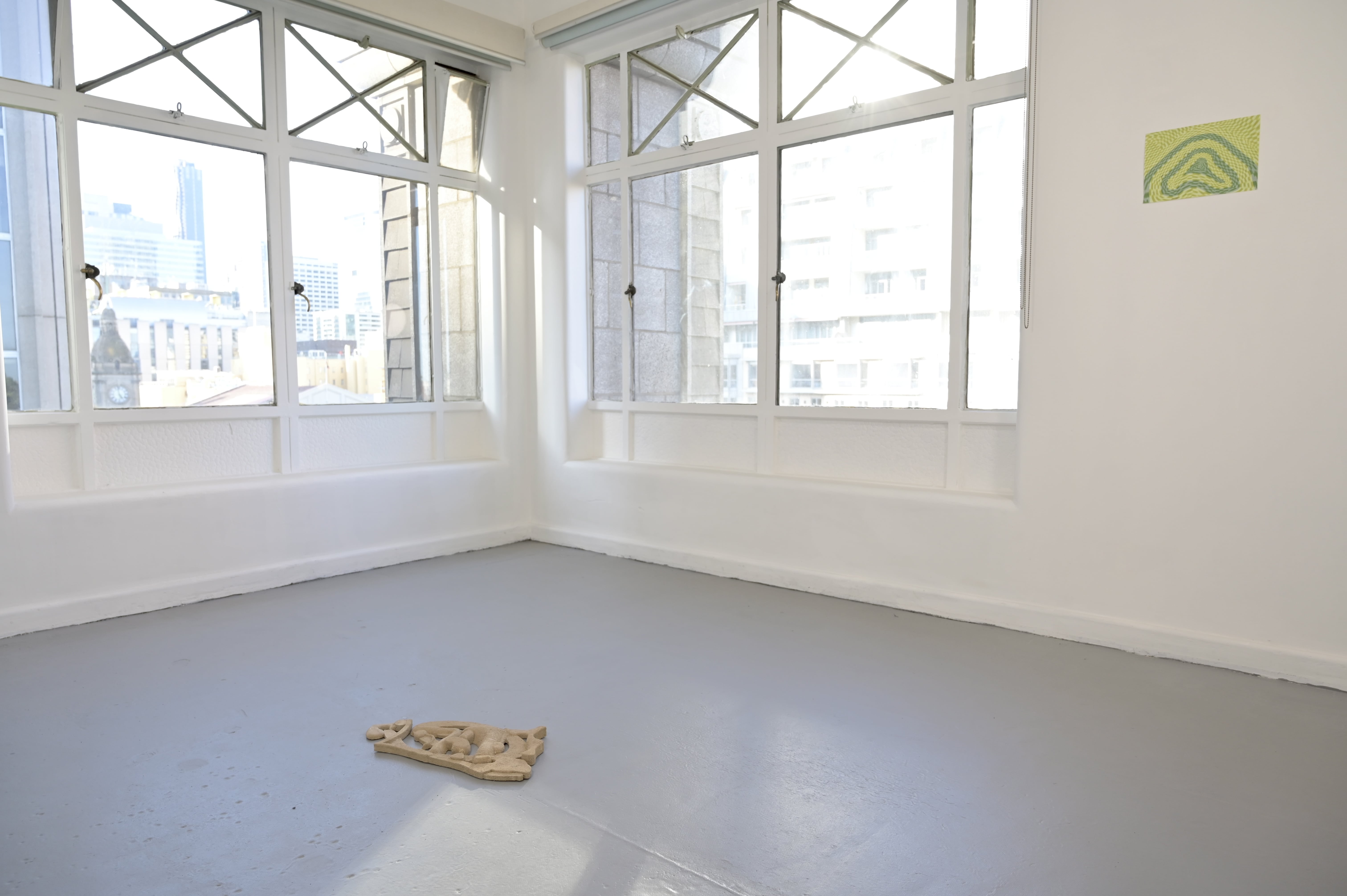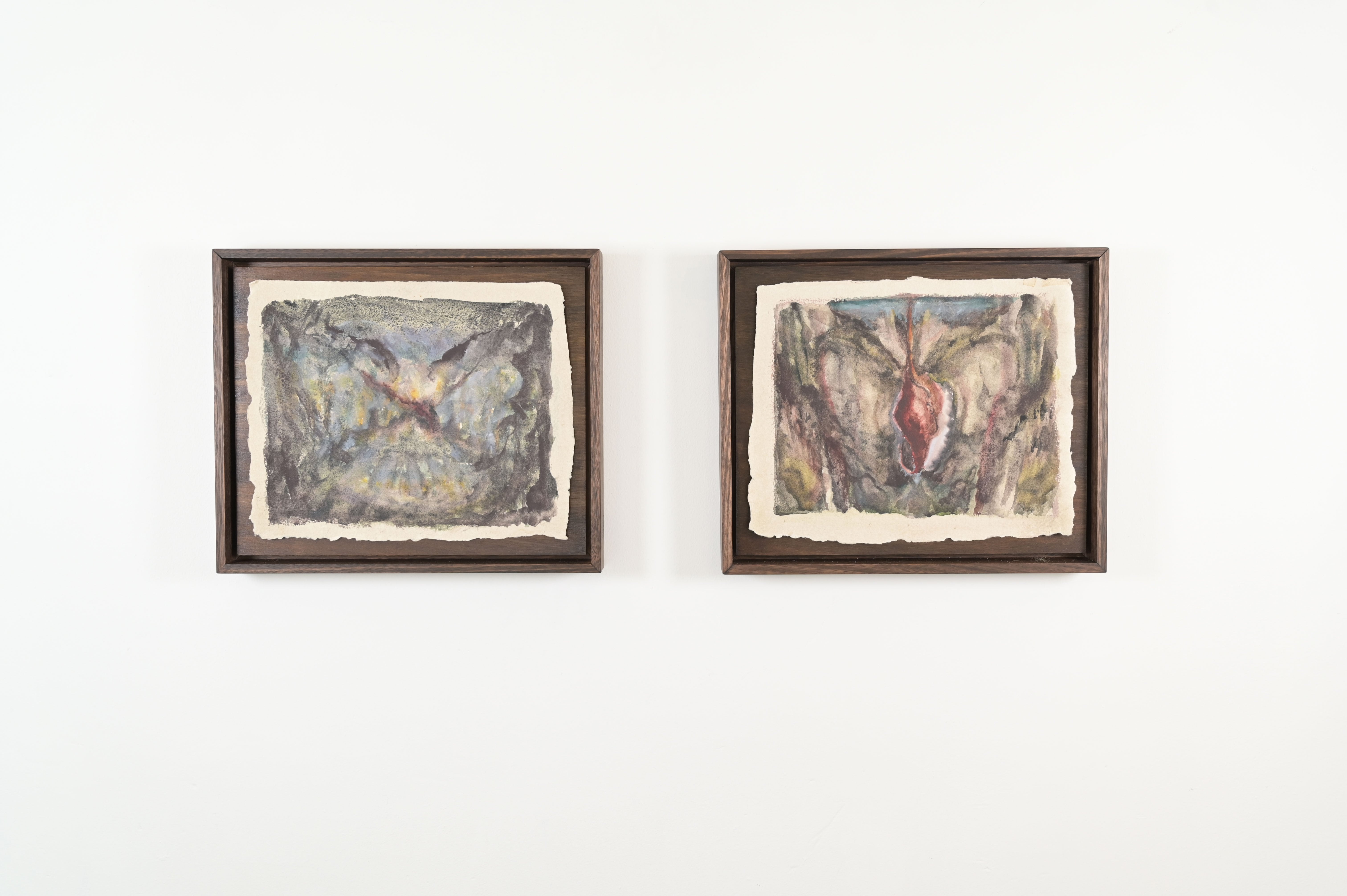

Artists: Beau Emmett, Jordan Halsall, Reiko Miyazawa,
John-Elio Reitman, and Victoria StolzCurator: Kathryne Genevieve Honey
Artist’s Artists was the last show at CAVES to run its course without a live audience to parse the work of its contributors in real time. Like much visual art programming in Naarm/Melbourne over the past eight months, the exhibition was physically installed but delivered by proxies: the gallery’s website, Instagram, a digital catalogue and its hard copy iteration—available free of charge upon request. Whether apprehended visually with an emphasis on the possessive noun, or aurally as a repeated plural (artists artists), the title prefaces the doubling down of creative input during a time of attrition and attenuation in the arts industries at large, a doubling down to which Artist’s Artists wholly committed.
Curator Kathryn Honey’s rationale accompanied each of CAVES’ Instagram posts promoting the exhibition. Repeated over the course of the show’s three week duration, and which it only seems right to quote in full again in this context, the following phrases took on a paeanistic quality:
Curated by Kathryne Genevieve Honey, Artist’s Artists began with a selection of artists who were asked to nominate a practitioner that they hold in high esteem to take the place of themselves in the exhibition. At its core the project responds to how we can each help and inspire one another, and how we maintain our sense of community in this tumultuous time. This exhibition extends a hand in solidarity, in admiration and benevolence. Lou Hubbard invited Victoria Stolz, Susan Jacobs invited Beau Emmett, Nicholas Mangan invited Jordan Halsall, Jackson Slattery invited John-Elio Reitman and curator Kathryne Genevieve Honey invited Reiko Miyazawa.
The repetition of this statement served to reinforce the curatorial paradigm established by Honey — with the act of substitution, or the Deleuzian de-and-then-re-territorialization that underscored the development of the artist list — reflected in the means by which we could interact with the exhibition.
I received my physical copy of the exhibition catalogue in the post a couple of days before the show’s closure. This simple publication was a welcome tangible index of the (then) barred act of gallery visitation, providing respite from the now ubiquitous online viewing room. Forgoing a checklist of works, the catalogue consists of a curatorial essay by Honey, a reflection from gallery director Storm Gold on CAVES’ beginnings as a ‘one-off painting show’ and its current role as a platform that supports new and established practitioners alike, and responses from the initial group of artists explaining who they invited to exhibit. The print catalogue also included a series of loose inserts not accessible via the pdf version, featuring additional materials conceived by the artists. Miyazawa was represented by six photographs taken on her daily walks around Fitzroy Gardens, Emmet described the motivation behind his nocturnal images, Reitman shared five haikus and one free verse and Halsall offered a recipe for a ‘complete food formula’ featuring nutritional substances and additives such as lecithin, potassium chloride and xanthan gum. Small design variations — in font, paper colour and format — helped to distinguish between the makers across the suite.1
The Artist’s Artists catalogue is responsive to the recent destablisation of traditional sites of artistic creation and presentation, and their potential to be reconstituted in alternative loci, both physically and virtually. The agency the catalogue possesses as a discrete creative pursuit, as well as its distribution free of charge, recalls the Seth Seigelaub 1969 catalogue-cum-exhibition March 1-31. Credited as ‘the first exhibition to exist in catalogue form alone; distributed free worldwide,’2 this landmark document is still available for access. Moving beyond the concerns of conceptual artists wanting to liberate artworks from the necessity of being made and from the art world’s capitalist structures, however, the Artist’s Artists catalogue — in both its physical and virtual form — provides a conduit for the show’s altruistic curatorial premise to extend its proliferation. Just as the act of exhibiting has been re-territorialised within the ‘nominated’ group of artists, so too has the catalogue been reconfigured as a site of primary encounters and first hand experiences. It is under the combined imprint of benevolence and agility that we are introduced to the artists and their works.
John Elio Reitman’s watercolours depict both neutral and nettled sinus tracts blooming below the dermis, internal and external systems conflating on the picture plane. These cavities share a consonance with Jordan Halsall’s low relief sculptures which, created from materials including masa harina (a type of corn flour), pea protein concentrate and woodchips, can be contextualised as active allergens capable of affecting a reaction within such receptive passages. Whorling, diagrammatic and the product of prolonged observation, Reiko Miyazawa’s pencil drawings emerged from the daily ritual of the ‘lockdown walk’. Reckoning with the alienness of Miyazawa’s images — even viewed through the mediation of a screen — can be likened to a visual experience of semantic satiation, the psychological phenomenon by which repetition causes a word or phrase to temporarily lose meaning. The source imagery she references, fountains in this instance, become abstracted and unfamiliar, her compositions instead tracing invisible energies and sensations.
Newly formed habits are also the basis of Beau Emmet’s and Victoria Stoltz’s works. Emmet’s photographs document the ‘nyctophyllic goings on’ in his backyard, to which he has become increasingly attuned during lockdown. Illuminated by camera flash or bike light, flowers come forth from the void, with cotton rag supports lending lustre to his attempts at seeing through the dark. Stoltz’s framed watercolours harbour mysterious and organic connotations. Resembling a gaping maw or dangling gland, the bleeds and washes of mineral-rich pigments take their inspiration from the evening walks the artist takes around her studio in the Blue Mountains.
Alongside the acts of generosity, collaboration and the bolstering of artistic networks this project stemmed from, the leitmotif of the longue durée, or the cinematic ‘long take’, can be discerned throughout Artist’s Artists rhizomatic character. Within the catalogue, many of the original group of invited artists cite the length of time they have followed their selected artist and their work; part of Storm Gold’s email ‘conversation in passing’ with CAVES’ former co-director Kez Hughes in 2014, in which they discussed curating a show together (which would eventually and unintentionally lead to the foundation of CAVES), is reproduced; and Honey expresses her pleasure in finally working with Miyazawa after first seeing her works in 2015. Artist’s Artists was a timely summation of the ways that perseverance and community function as basal elements of the visual arts ecology, this elemental rubric echoed in the final call to action of Halsall’s nutritionally complete concoction: “Look down at this mix. This is all you will ever need."
Deirdre is a curator and writer living in Naarm/Melbourne.
